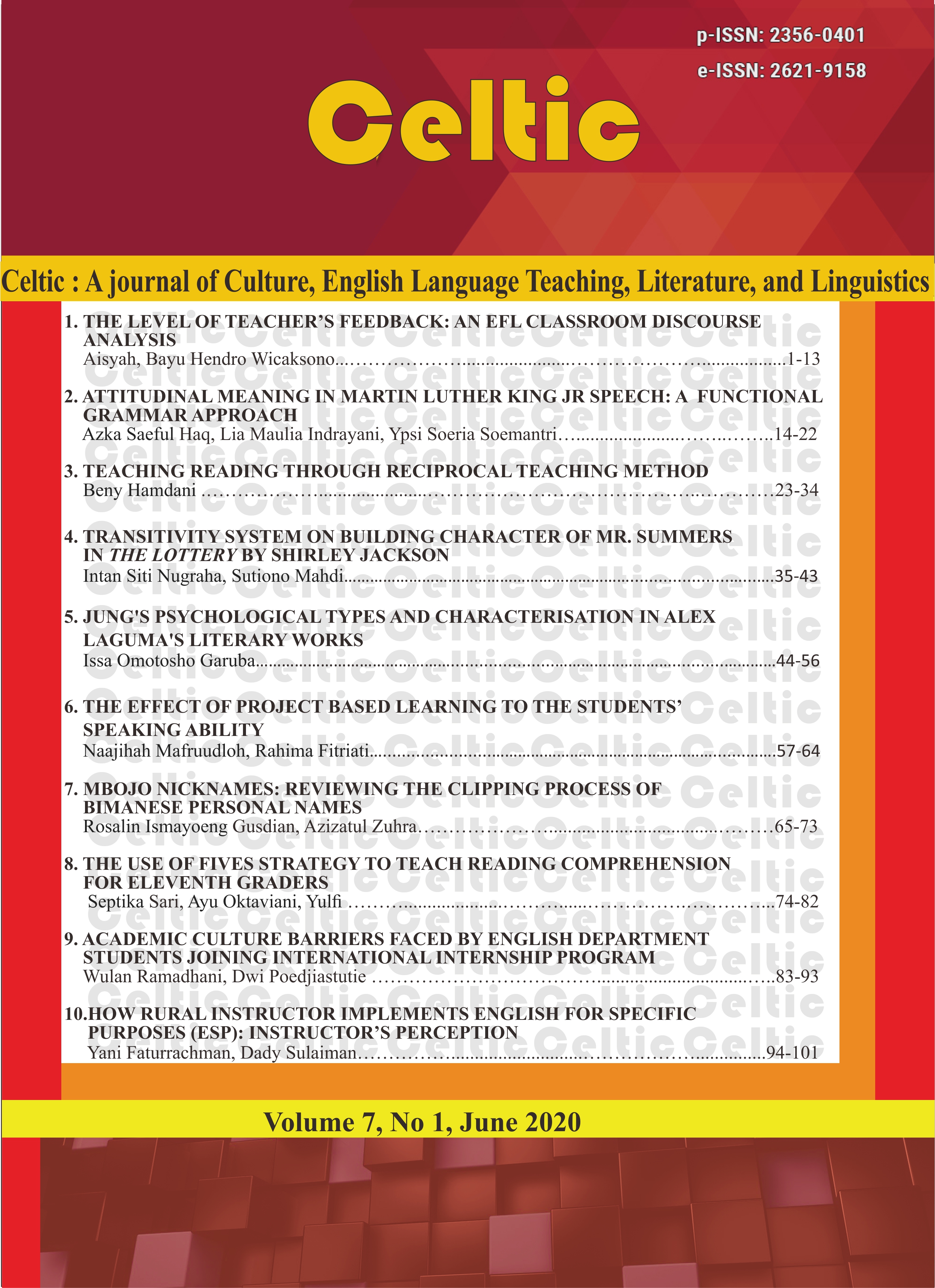THE USE OF FIVES STRATEGY TO TEACH READING COMPREHENSION FOR ELEVENTH GRADERS
DOI:
https://doi.org/10.22219/celtic.v7i1.11503Keywords:
FIVES Strategy, Reading Comprehension, TeachingAbstract
One of the objectives that should be developed in teaching is reading comprehension skills. In fact, many students still have a lot of problems with reading. Therefore, teachers should use specific strategies in teaching reading comprehension to resolve students’ difficulties. The purpose of the research was to find out whether or not it is significantly effective to teach reading comprehension by using the FIVES strategy for eleventh-grade students of SMA Negeri 2 Lubuklinggau. This research applied the pre-experimental method with one group pre- and post-test only. The population of the study was all of the eleventh-grade students of SMA Negeri 2 Lubuklinggau. Cluster random sampling was taken to take the sample class. Class XI MIA 4 was chosen as the sample class. The data was collected through a reading test consisted of 20 items of multiple-choice form. The results of this research were: 1) the average score in the pre-test was 61.81, and the post-test was 78.06, 2) the result of the Paired t-test was 10.167, which higher than t-table (1.689) at the significant level of 5% with df 35. Therefore, the alternative hypotheses (Ha) was accepted. It means that it was significantly effective to teach reading comprehension by using the FIVES strategy for eleventh-grade students of SMA Negeri 2 Lubuklinggau.
Downloads
References
Antoni, D. (2017). The Effect of Anticipation Guide Strategy and Students’ Reading Interest on Students’ Reading Comprehension at Grade XII of SMKN 1 Pariaman. English Language Teaching and Research. 1(1). 65-76
Brown, H. D. (2004). Language assessment: principles and classroom practices. New York: Pearson Education.
Caldwell, J. S. (2008). Reading assessment: a primer for teachers and coaches (2nd ed.). New York: The Guilford Press.
Fraenkel, J. R., & Wallen, N. E. (2009). How to design and evaluate research in education (7th ed.). New York: McGraw Hill Education.
Gay, L. R., Mills, G. E., & Airasian, P. (2012). Educational research: Competencies for analysis and applications (10th ed.). United States of America: Pearson Education.
Hadyan, R. (2013). Implementation of the cooperative learning method in teaching reading comprehension. Journal of English and Education, 1(2), 57-64.
Mikulecky, B. S., & Jeffries, L. (2007). Advanced reading power: : extensive reading, vocabulary building, comprehension skills, reading faster. New York: Pearson Education.
Nuriati., Ohoiwutun, J. E., & Mashuri. (2015). Improving students’ reading comprehension by using buzz group technique. E-Journal of English Language Teaching Society, 3(2), 1-10.
Rustam, A. (2016). Dasar-dasar Statistik. Kolaka: Putri Yolanda.
Shea, M., & Roberts, N. (2016). Fives: an integrated strategy for comprehension and vocabulary learning. Journal of Inquiry & Action in Education, 8(1), 95-97.
Syaprizal. (2016). Using pictorial context in pre reading in reading activity to the eighth grade students of smp negeri air satan. Jurnal Perspektif Pendidikan, 10(1), 23-31.
Tankersley, K. (2003). The threads of reading: Strategies for literacy development. Virginia: Association for Supervision and Curriculum Development.
Walliman, N. (2011). Research methods: The basics. New York: Routledge.
Westwood, P. (2001). Reading and learning difficulties: Approaches to teaching and assessment. Victoria: Acer Press.
Downloads
Published
How to Cite
Issue
Section
License
- Authors retain copyright to publish without restrictions and grant the journal right of first publication with the work simultaneously licensed under a Creative Commons Attribution License that allows others to share the work with an acknowledgement of the work's authorship and initial publication in this journal.
- Authors are able to enter into separate, additional contractual arrangements for the non-exclusive distribution of the journal's published version of the work (e.g., post it to an institutional repository or publish it in a book), with an acknowledgement of its initial publication in this journal.
- Authors are permitted and encouraged to post their work online (e.g., in institutional repositories or on their website) prior to and during the submission process, as it can lead to productive exchanges, as well as earlier and greater citation of published work.














